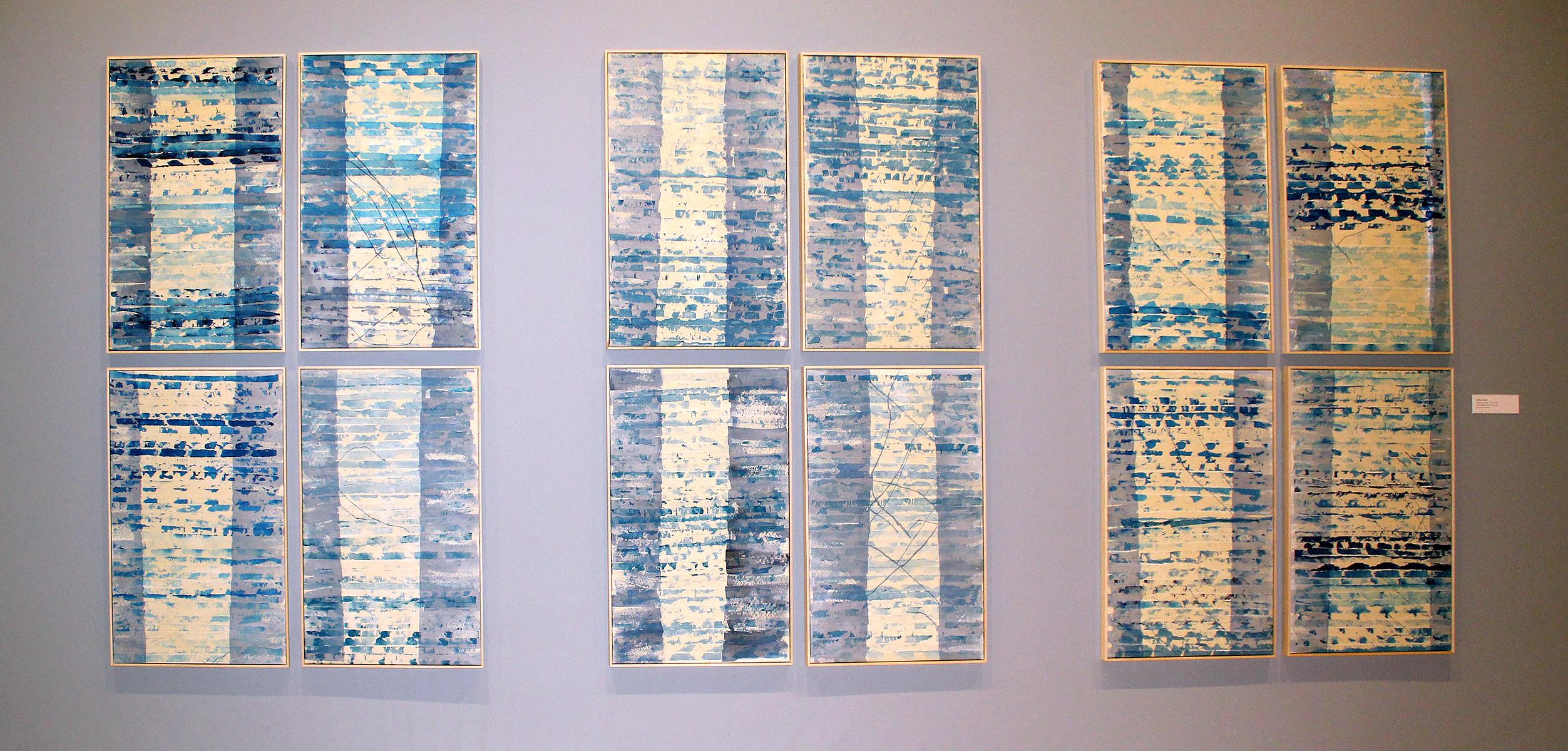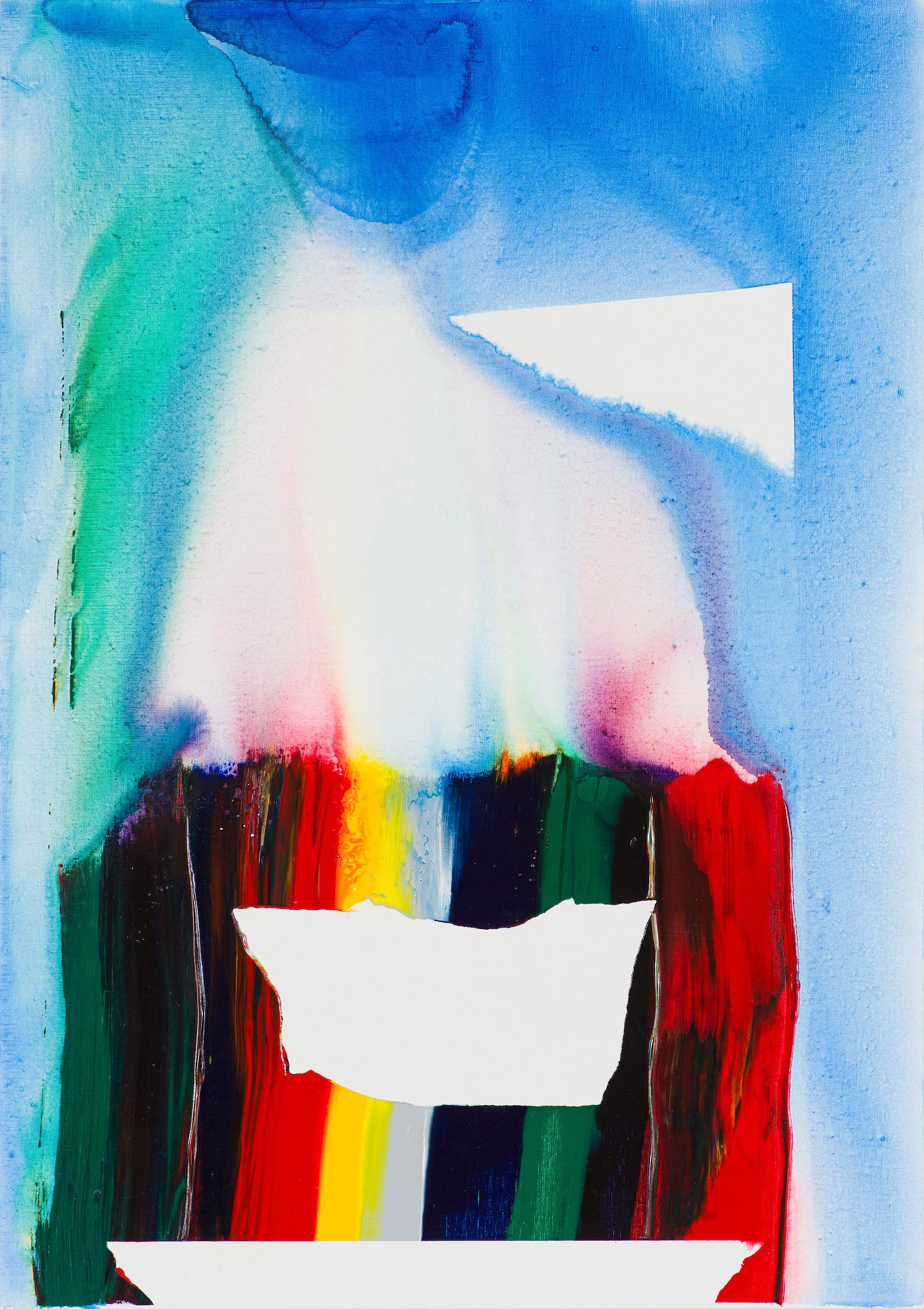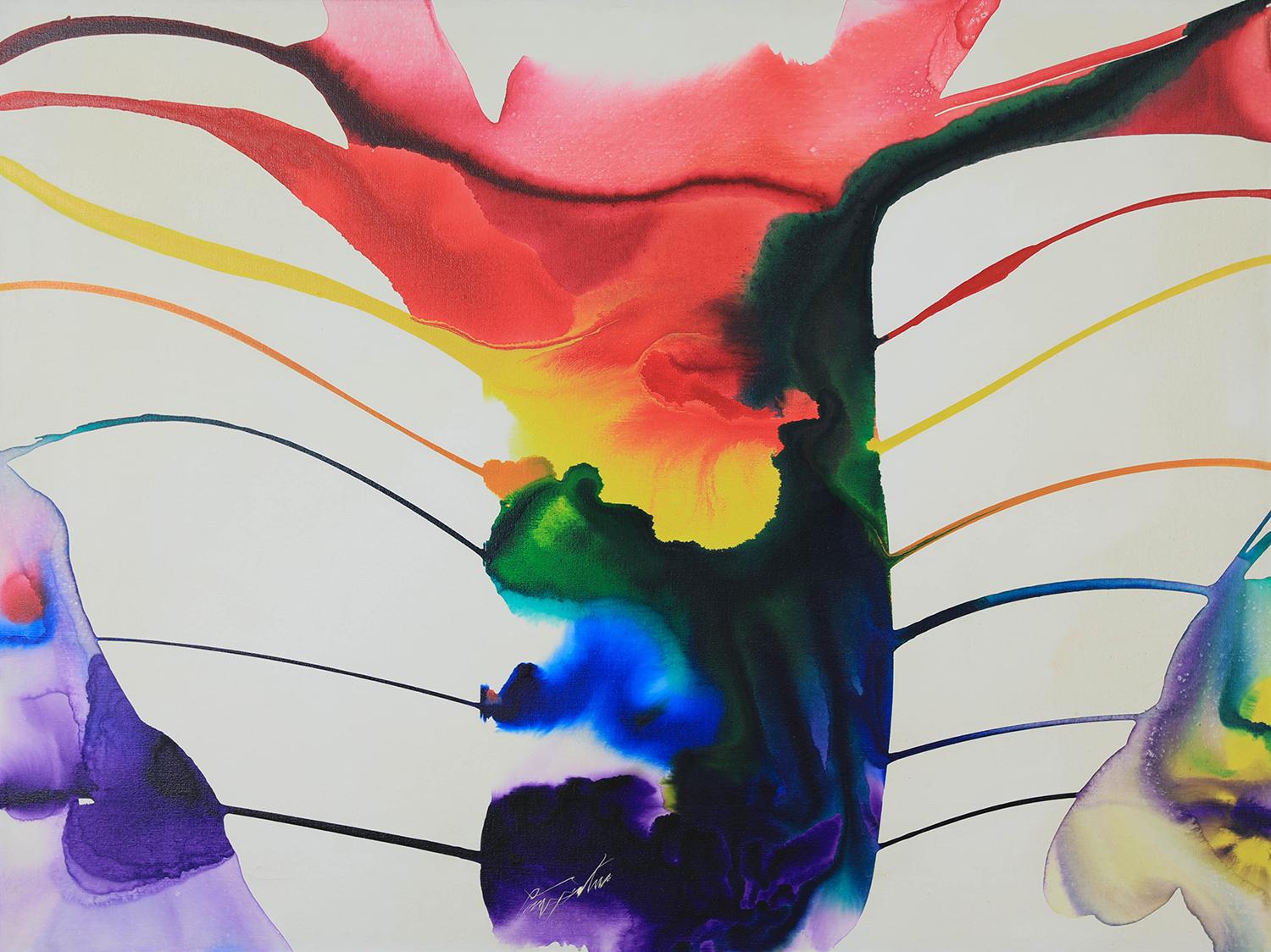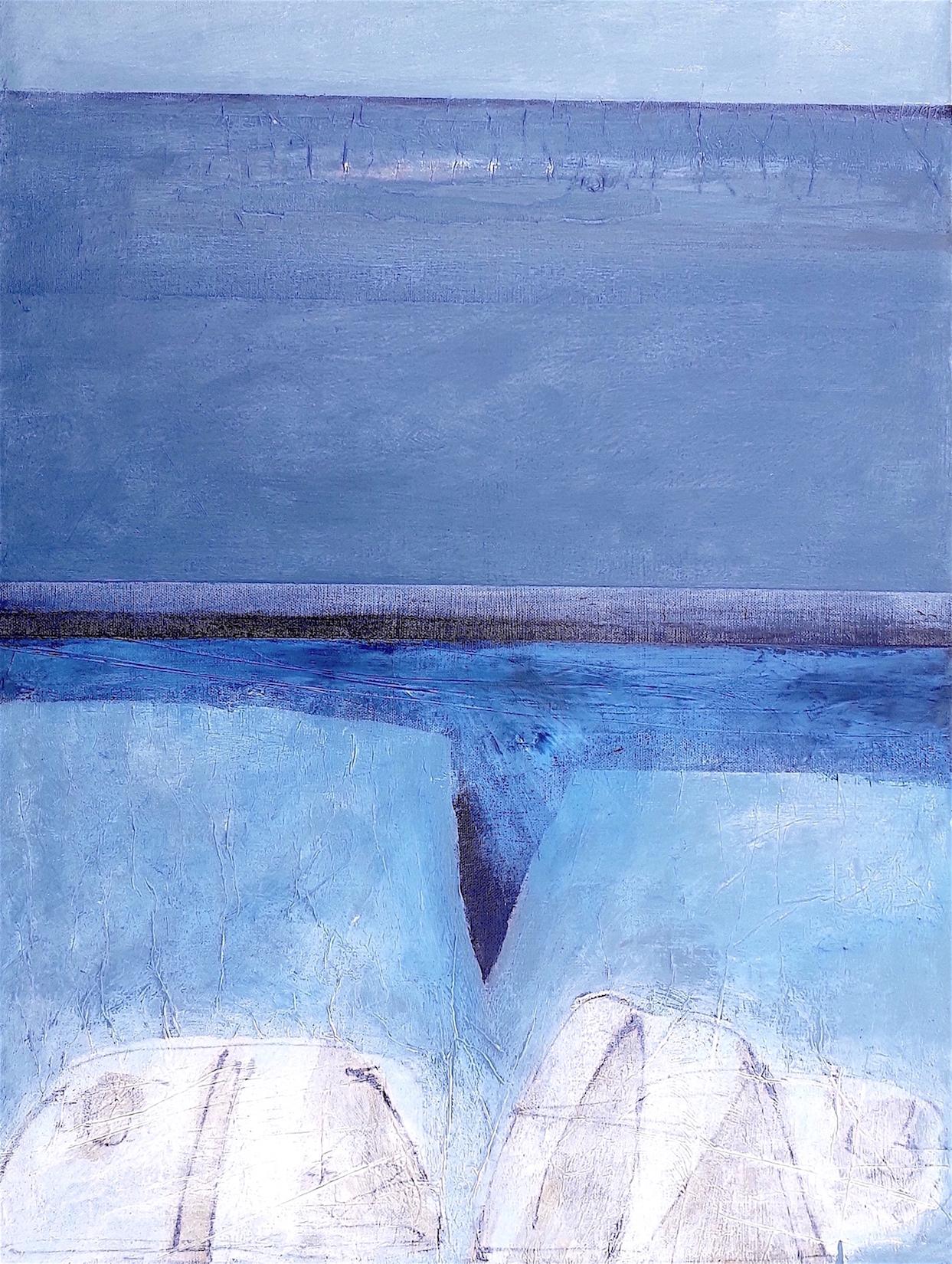Items Similar to "Staccato I"
Want more images or videos?
Request additional images or videos from the seller
1 of 6
Solomon Ethe"Staccato I"2016
2016
About the Item
Jim's of Lambertville is proud to present this artwork by Solomon Ethe (1924 – 2019)
Solomon Ethe was born on June 22, 1924. A native New Yorker, he received a Masters of Business Administration from Columbia University before continuing onto a career as an economist for 15 years. During his term as an economist, Ethe began to collect the works of many distinguished modern artists, such as Paul Klee, Piet Mondrian, Joseph Cornell, Joan Miró, Francis Picabia, Kazimir Malevich, and František Kupka. Surrounded by these masterful compositions, Ethe's interest in artistic pursuits blossomed, and, in 1960, he opened his first studio in the Flatiron District of New York.
Ethe was entirely self-taught. He used his art collection as reference and study materials to develop his Non-Objective Expressionist style. Ethe's aesthetic is a clear combination of artistic principles pulled from these artists. When viewing his paintings, one can see the influence of Mondrian's geometric grids, the colorful abstractions of Severini and Kupka, Klee and Miró's expressive colorfields, as well as Malevich's commitment to pure abstraction. Ethe was also guided by the techniques of automated drawing and subconscious creation practiced by several of these artists. In these methods, the artist employs "a spontaneous and free-form interaction with the work in progress." Many critics have remarked on the lyrical optimism demonstrated in his paintings, pronounced in evocative brushstrokes, sharp geometric forms, and bright colors, creating a spiritual effect on the viewer.
Ethe has exhibited extensively at New York galleries from 1963 until 2016. His works have also been featured at the Aldrich Museum of Contemporary Art in Ridgefield, CT, 1974; the Huntington Hartford Museum's Gallery of Modern Art in New York, 1968; and the Pennsylvania Academy of the Fine Arts in Philadelphia, PA, 1966. His painting “Concentration” appeared on the cover of the book, Dislocated Memories: Jews, Music and Post War German Culture by Tina Frühauf, published by Oxford University Press in 2014.
Solomon Ethe passed away on March 29, 2019.
- Creator:Solomon Ethe (1924 - 2019)
- Creation Year:2016
- Dimensions:Height: 20 in (50.8 cm)Width: 16 in (40.64 cm)
- Medium:
- Movement & Style:
- Period:
- Condition:
- Gallery Location:Lambertville, NJ
- Reference Number:
About the Seller
5.0
Vetted Seller
These experienced sellers undergo a comprehensive evaluation by our team of in-house experts.
Established in 1997
1stDibs seller since 2014
36 sales on 1stDibs
Typical response time: 4 hours
- ShippingRetrieving quote...Ships From: Lambertville, NJ
- Return PolicyThis item cannot be returned.
More From This SellerView All
- "Staccato XI"By Solomon EtheLocated in Lambertville, NJJim's of Lambertville is proud to present this artwork by Solomon Ethe (1924 – 2019) Solomon Ethe was born on June 22, 1924. A native New Yorker, he rece...Category
2010s Abstract Expressionist Abstract Paintings
MaterialsCanvas, Acrylic
- "Simorgh"By Solomon EtheLocated in Lambertville, NJJim's of Lambertville is proud to offer this artwork by Solomon Ethe (1924 – 2019) Solomon Ethe was born on June 22, 1924. A native New Yorker, he receiv...Category
1980s Abstract Expressionist Abstract Paintings
MaterialsCanvas, Oil
- "Blue Abstraction" (from the Blue I Series)By Solomon EtheLocated in Lambertville, NJJim's of Lambertville is proud to offer this artwork by Solomon Ethe (1924 – 2019) Solomon Ethe was born on June 22, 1924. A native New Yorker, he rece...Category
1970s Abstract Expressionist Abstract Paintings
MaterialsCanvas, Oil
- "Manhattan Night Life"By Vaclav VytlacilLocated in Lambertville, NJJim’s of Lambertville is proud to offer this artwork by: Vaclav Vytlacil (1892-1984) He was born to Czechoslovakian parents in 1892 in New York City. Living in Chicago as a youth, he took classes at the School of the Art Institute of Chicago, returning to New York when he was 20. From 1913 to 1916, he enjoyed a scholarship from the Art Students League, and worked with John C. Johansen (a portraitist whose expressive style resembled that of John Singer Sargent), and Anders Zorn. He accepted a teaching position at the Minneapolis School of Art in 1916, remaining there until 1921. This enabled him to travel to Europe to study Cézanne’s paintings and works of the Old Masters. He traveled to Paris, Prague, Dresden, Berlin, and Munich seeking the works of Titian, Cranach, Rembrandt, Veronese, and Holbein, which gave him new perspective. Vytlacil studied at the Royal Academy of Art in Munich, settling there in 1921. Fellow students were Ernest Thurn and Worth Ryder, who introduced him to famous abstractionist Hans Hofmann. He worked with Hofmann from about 1922 to 1926, as a student and teaching assistant. During the summer of 1928, after returning to the United States, Vytlacil gave lectures at the University of California, Berkeley, on modern European art. Soon thereafter, he became a member of the Art Students League faculty. After one year, he returned to Europe and successfully persuaded Hofmann to teach at the League as well. He spent about six years in Europe, studying the works of Matisse, Picasso, and Dufy. In 1935, he returned to New York and became a co-founder of the American Abstract Artists group in 1936. He later had teaching posts at Queens College in New York; the College of Arts and Crafts in Oakland, California; Black Mountain College in North Carolina; and the Art Students League. His paintings exhibit a clear inclination toward modernism. His still lives and interiors from the 1920s indicate an understanding of the art of Cézanne. In the 1930s, his works displayed two very different kinds of art at the same time. His cityscapes and landscapes combine Cubist-inspired spatial concerns with an expressionistic approach to line and color. Vytlacil also used old wood, metal, cork, and string in constructions, influenced by his friend and former student, Rupert Turnbull. He eventually ceased creating constructions as he considered them too limiting. The spatial challenges of painting were still his preference. During the 1940s and 1950s, his works indicated a sense of spontaneity not felt in his earlier work. He married Elizabeth Foster in Florence, Italy, in 1927 and they lived and worked in Positano, Italy for extended periods of time. Later on, they divided their time between homes in Sparkill, New York and Chilmark, Massachusetts, where Vyt, as he was affectionately called, taught at the Martha's Vineyard Art...Category
1930s Abstract Expressionist Abstract Paintings
MaterialsCanvas, Oil
- "Deer Isle, Maine"By Mercedes MatterLocated in Lambertville, NJJim’s of Lambertville is proud to offer this artwork by: Mercedes Matter (1913 - 2001) Best known as a painter of abstract still life and founder of the New York Studio School, M...Category
1950s Abstract Expressionist Abstract Paintings
MaterialsCanvas, Oil
- “Woman in Black”By Vaclav VytlacilLocated in Lambertville, NJJim’s of Lambertville is proud to offer this artwork by: Vaclav Vytlacil (1892-1984) He was born to Czechoslovakian parents in 1892 in New York City. Living in Chicago as a youth, he took classes at the School of the Art Institute of Chicago, returning to New York when he was 20. From 1913 to 1916, he enjoyed a scholarship from the Art Students League, and worked with John C. Johansen (a portraitist whose expressive style resembled that of John Singer Sargent), and Anders Zorn. He accepted a teaching position at the Minneapolis School of Art in 1916, remaining there until 1921. This enabled him to travel to Europe to study Cézanne’s paintings and works of the Old Masters. He traveled to Paris, Prague, Dresden, Berlin, and Munich seeking the works of Titian, Cranach, Rembrandt, Veronese, and Holbein, which gave him new perspective. Vytlacil studied at the Royal Academy of Art in Munich, settling there in 1921. Fellow students were Ernest Thurn and Worth Ryder, who introduced him to famous abstractionist Hans Hofmann. He worked with Hofmann from about 1922 to 1926, as a student and teaching assistant. During the summer of 1928, after returning to the United States, Vytlacil gave lectures at the University of California, Berkeley, on modern European art. Soon thereafter, he became a member of the Art Students League faculty. After one year, he returned to Europe and successfully persuaded Hofmann to teach at the League as well. He spent about six years in Europe, studying the works of Matisse, Picasso, and Dufy. In 1935, he returned to New York and became a co-founder of the American Abstract Artists group in 1936. He later had teaching posts at Queens College in New York; the College of Arts and Crafts in Oakland, California; Black Mountain College in North Carolina; and the Art Students League. His paintings exhibit a clear inclination toward modernism. His still lives and interiors from the 1920s indicate an understanding of the art of Cézanne. In the 1930s, his works displayed two very different kinds of art at the same time. His cityscapes and landscapes combine Cubist-inspired spatial concerns with an expressionistic approach to line and color. Vytlacil also used old wood, metal, cork, and string in constructions, influenced by his friend and former student, Rupert Turnbull. He eventually ceased creating constructions as he considered them too limiting. The spatial challenges of painting were still his preference. During the 1940s and 1950s, his works indicated a sense of spontaneity not felt in his earlier work. He married Elizabeth Foster in Florence, Italy, in 1927 and they lived and worked in Positano, Italy for extended periods of time. Later on, they divided their time between homes in Sparkill, New York and Chilmark, Massachusetts, where Vyt, as he was affectionately called, taught at the Martha's Vineyard Art...Category
1960s Abstract Expressionist Figurative Paintings
MaterialsOil, Board
You May Also Like
- Working Man, Large Oil Painting by Thornton Willis 1981Located in Long Island City, NYArtist: Thornton Willis, American (1936 - ) Title: Working Man Year: 1981 Medium: Acrylic on Canvas, signed and titled verso Size: 84 x 94 in. (213.36 ...Category
1980s Abstract Expressionist Abstract Paintings
MaterialsCanvas, Acrylic
- A Set of 12 Contemporary Framed Abstract Paintings Blue White Museum CollectionBy Monica AngleLocated in Buffalo, NYA set of 12 original mixed media monotype and painting mixed media works by American contemporary artist Monica Angle. These pieces were inspired by the changing light throughout th...Category
2010s Abstract Expressionist Abstract Paintings
MaterialsCanvas, Paper, Acrylic, Watercolor
- Phenomena Prism Mirror by Paul Jenkins - Abstract paintingBy Paul JenkinsLocated in London, GB*UK BUYERS WILL PAY AN ADDITIONAL 5% IMPORT DUTY ON TOP OF THE ABOVE PRICE Phenomena Prism Mirror by Paul Jenkins (1923-2012) Acrylic on canvas 147.3 x 1...Category
1980s Abstract Expressionist Abstract Paintings
MaterialsCanvas, Acrylic
- Phenomena Spectrum Guardian by Paul Jenkins, Abstract Expressionist artistBy Paul JenkinsLocated in London, GBPhenomena Spectrum Guardian by Paul Jenkins (1923 - 2012) Acrylic on canvas 76 x 101.5 cm (29 ⁷/₈ x 40 inches) Signed lower middle Paul Jenkins Executed in 1970 Provenance: Gallerie Iris Wazzau, Davos, Switzerland Private collection, Cologne, Germany Artist biography: Born at Kansas City in Missouri (USA), the multi-media artist, poet and playwright Paul Jenkins studied at the Kansas City Art Institute and the Art Students League in New York City. After his discharge from military service at the end of February 1946, he briefly studied playwriting with dramatist George McCalmon at the Carnegie Institute of Technology in Pittsburgh. Thereafter, Jenkins spent four years studying with Japanese American artist Yasuo Kuniyoshi in New York City. His first solo exhibitions were held at Studio Paul Facchetti in Paris in 1954 and the Martha Graham Gallery in New York City in 1956. Over the past thirty years, numerous retrospectives have been curated across the globe and Jenkins’ work can found in national collections from Europe and the United States to Israel, Australia and Japan. The diversity of his work springs from Jenkins’ wealth of eclectic influences. Some of his earliest works included what he called "interior landscapes" influenced by ancient natural forms like the caves he visited in the Ozark Mountains in his native-Missouri. Frequent student visits to the Frick Collection in New York fostered a love of the great masters: Bellini, Holbein, Vermeer, Rembrandt, de la Tour, Turner and Goya. In compliment, lingering student visits to the renowned Eastern collection of the Nelson-Atkins Museum of Art in Kansas City evoked powerful sympathy for a monumental Chinese fresco...Category
1970s Abstract Expressionist Abstract Paintings
MaterialsCanvas, Acrylic
- Celtic Song. Contemporary Abstract Expressionist PaintingBy Patricia McParlinLocated in Brecon, PowysPatricia McParlin, is an award winning British artist who lives and works in Wales. She studied at The University of Wales and The West Wales School of the Arts. She has recently b...Category
2010s Abstract Expressionist Abstract Paintings
MaterialsCanvas, Oil, Acrylic
- Demit Omphroy - Conversation, Painting 2022Located in Greenwich, CT“Conversation” represents the defining moment that one has with themselves around the decision to stay or leave the relationship. It is the final internal conversation where one has ...Category
2010s Abstract Expressionist Abstract Paintings
MaterialsCanvas, Paint, Cotton Canvas, Acrylic
Recently Viewed
View AllMore Ways To Browse
Joan Miro Cover
Joan Miro Book
Francis Picabia
Joan Miro 1974
Composition I Joan Miro
Flatiron Painting
Kupka Frantisek
Solomon Ethe Paintings
Solomon Ethe
Vintage North Bay
Alan Brown Artist
Antique Japanese Abstract Painting
Bear Tapestry
Emerald City Art
Graffiti Chicago
La Jolla Paintings
Nelson Pattern
Santo Domingo




